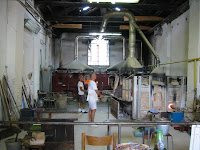Here's a pic of the pendant that started my glass obsession:

I had so much fun making pendants using slices of murrine but it seems that I'm not the only one who loves the look of millefiori - almost all of the pieces I made have been sold! Thankfully I was able to place an order to be shipped (which saved me driving 1.5 after work, or 2.5 hours from home!) to replenish my stock.
I spend the weekend making dichoric pendants and earrings and houseware items - plates, bowls, magnets and 2 tic-tac-toe boards. I registered as a vendor in an outdoor craft and artisan market for a few Saturdays this summer so I needed to start building my inventory. Hopefully I'll get back to millefiori next weekend.
These pieces are made with only murrine slices. About 40 to 50 pieces of cane in each pendant and multiple firings were needed to achieve the desired effect:









More pendants. These were made using murrine pieces but have a base of clear, black or white glass.












For those that are interested in a little education: The millefiori technique involves the production of glass canes or rods, known as murrine, with multicolored patterns which are viewable only from the cut ends of the cane. To make the canes the glassmaker gathers molten glass on an iron rod called a pontil, then the heated glass is dipped into a mold (that shapes the glass). The glass is cooled and the process is repeated over and over again, until the design is completed and the cane consists of several layers of glass.
In the next step, the canes are reheated and an iron rod is attached to each end this time, instead of just one end. While the glass is still hot it has to be stretched and pulled. This requires two people, one on either end of the glass, each holding a iron rod. It is a bit like pulling taffy, but more precise.
One day I would like to try and make my own murrine canes but for now I'm quite happy buying them already made. Somehow I don't think I'll ever be able to get away with building a glass furnace in my house and they can't be made in a kiln.
Watching glass artisans at a furnace on Murano island:

















